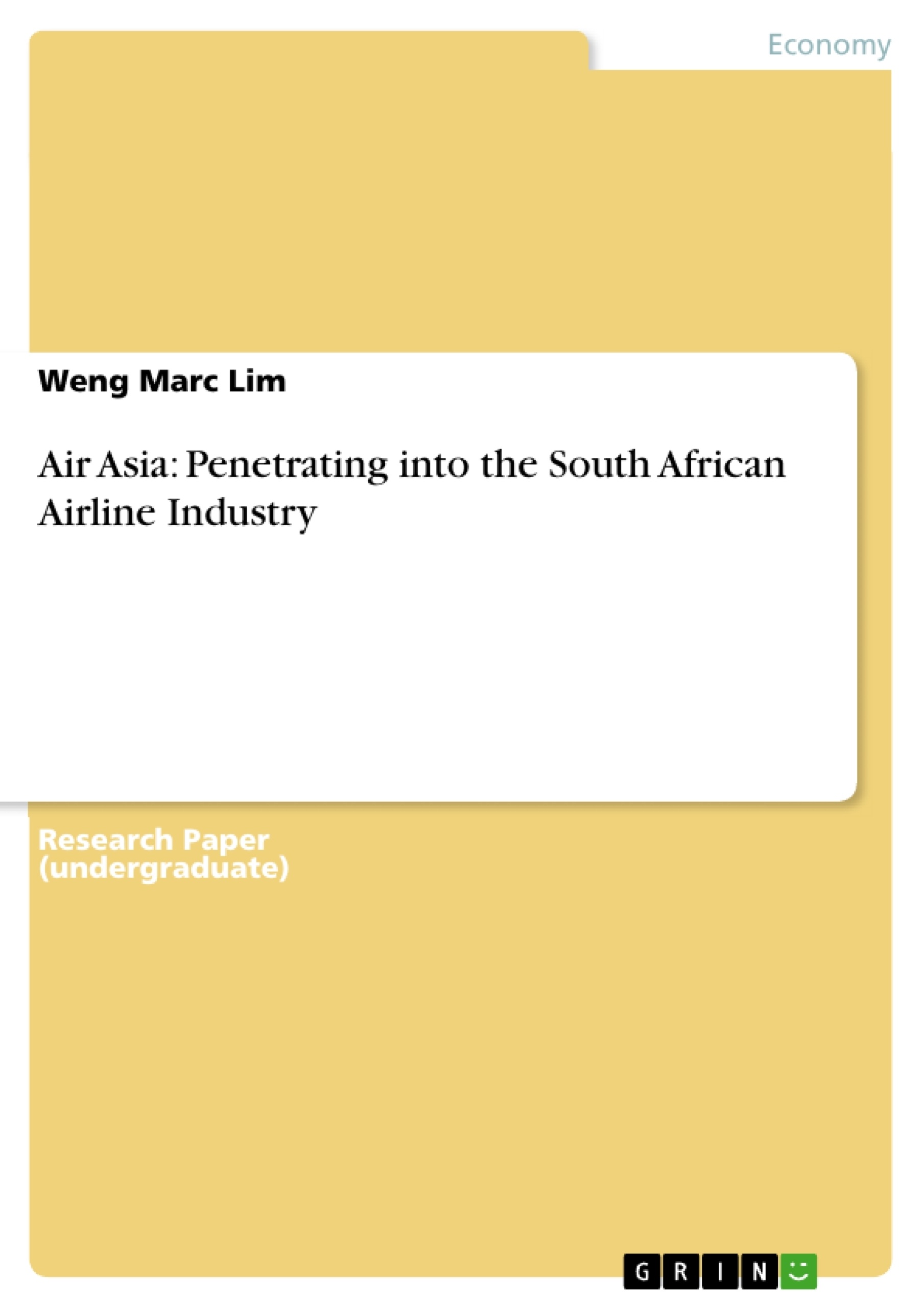Air Asia is a low-cost carrier based in Kuala, Lumpur Malaysia which flies to
over 66 successfully penetrated destinations in 18 countries worldwide.
Nevertheless, this innovative organisation continuously seeks new potential
markets for its investment. However, not all countries are an attractive prospect
for a new investment. This book presents an analysis on the attractiveness of
the South African airline industry along with Air Asia’s current internal states
and strategies in an attempt to rationalise the viability of an investment decision
into the state. The data collected entails from secondary sources ranging from
academic journal articles, organisational websites and reports, online
newspapers, to various databases. The main findings includes a favourable yet
challenging immediate and macroeconomic environment conditions in South
Africa, supporting internal strengths that were aligned with most key success
factors for the investment plan taking into account certain drawbacks identified,
and a well-positioned business-level and corporate-level strategy to take on a
new investment in the state. It is concluded that the South African airline
industry is a viable market in which Air Asia is able to weather those obstacles
and achieve great success. Nonetheless, Air Asia is recommended to play safe
and currently penetrate the industry on a smaller scale before operating in a
larger scale.
Inhaltsverzeichnis (Table of Contents)
- 1.0 Introduction
- 2.0 Strategic Analysis
- 2.1 Industry and competitive conditions
- 2.1.1 The immediate environment
- 2.1.1.1 Intensity of rivalry among established airlines
- 2.1.1.2 Risk of entry by prospective competitors
- 2.1.1.3 Threat of substitutes
- 2.1.1.4 Bargaining power of suppliers
- 2.1.1.5 Bargaining power of buyers
- 2.1.2 The macroeconomic environment
- 2.1.2.1 The economic environment
- 2.1.2.1 The social environment
- 2.1.3 Key success factors (KSFs)
- 2.2 Internal environment
- 2.2.1 Distinctive competencies
- 2.2.1.1. Ability to maximise aircraft space utilisation
- 2.2.1.2 Lean product line
- 2.2.1.3 Good management foresight
- 2.2.1.4 Fast turnaround time
- 2.2.1.5 Good supplier relations
- 2.2.2 Drawbacks
- 2.2.2.1 Security
- 2.2.2.2 Questionable on-time performance
- 2.3 Business and corporate level strategies
- 2.3.1 Current market positioning
- 2.3.2 Growth and development strategies
- 2.3.3 Obstacles
- 3.0 Recommendations
Zielsetzung und Themenschwerpunkte (Objectives and Key Themes)
This book aims to evaluate the viability of Air Asia expanding its operations into the South African airline industry. It analyzes the industry's attractiveness for a new investment, considering both the immediate and macroeconomic environments, as well as Air Asia's internal strengths and strategies.
- The attractiveness of the South African airline industry for a new investment by Air Asia.
- The internal environment and strengths of Air Asia.
- The business and corporate level strategies employed by Air Asia.
- The identification of key success factors (KSFs) for the investment.
- The recommendation for Air Asia's entry into the South African market.
Zusammenfassung der Kapitel (Chapter Summaries)
The book begins by introducing Air Asia, a low-cost carrier seeking to expand its operations globally. The introduction details the scope of the analysis, which focuses on the South African airline industry, Air Asia's internal environment, and its business and corporate strategies. The analysis uses secondary data sources to avoid making assumptions.
Chapter 2 delves into the strategic analysis, examining both the industry and competitive conditions in South Africa. It assesses the immediate environment, including factors such as the intensity of rivalry, potential competition, substitutes, and the bargaining power of suppliers and buyers. The chapter further explores the macroeconomic environment, considering economic and social factors that influence the airline industry.
The internal environment of Air Asia is discussed in Chapter 2. This chapter highlights the distinctive competencies of Air Asia, such as its ability to maximize aircraft space utilization, lean product line, good management foresight, fast turnaround time, and strong supplier relationships. It also identifies drawbacks like security concerns and questionable on-time performance.
Chapter 2 also examines Air Asia's business and corporate level strategies. It analyzes the current market positioning, growth and development strategies, and potential obstacles facing the company. The analysis provides a comprehensive understanding of Air Asia's strategic approach.
Schlüsselwörter (Keywords)
The key terms and concepts explored in this work include low-cost carriers, airline industry, investment analysis, South African economy, competitive environment, key success factors, distinctive competencies, business and corporate strategies, and market penetration. The analysis focuses on evaluating the viability of Air Asia's entry into the South African airline industry, considering both internal and external factors.
- Citation du texte
- Weng Marc Lim (Auteur), 2009, Air Asia: Penetrating into the South African Airline Industry, Munich, GRIN Verlag, https://www.grin.com/document/188545



